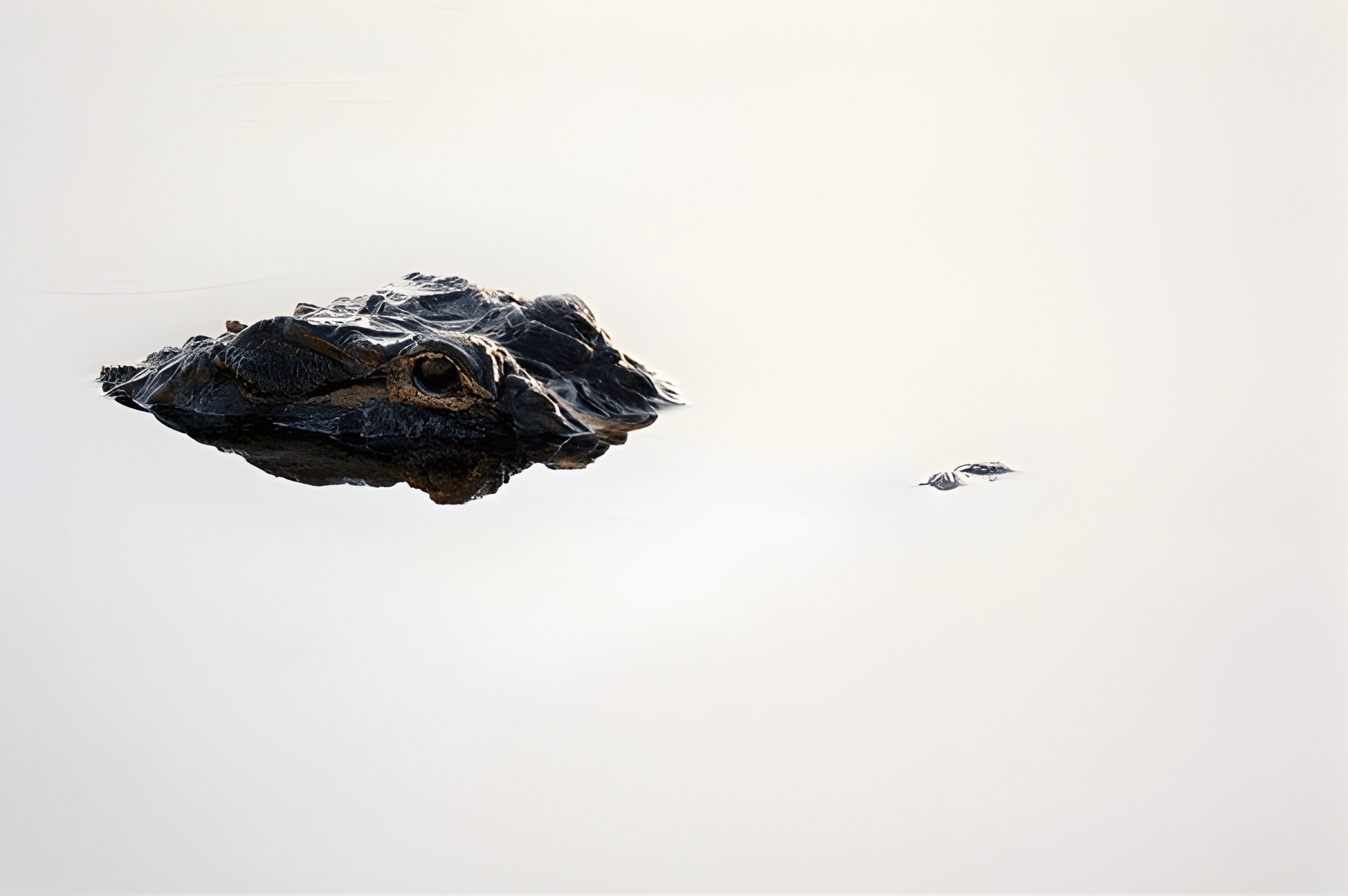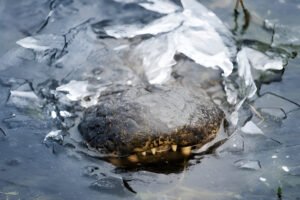Image Credit: ShutterStock
In the chilly waters of North Carolina, a remarkable phenomenon catches the attention of scientists and nature enthusiasts alike. Frozen alligators, their snouts peeking above the ice, have become an unexpected winter spectacle. This unusual sight raises questions about how these cold-blooded reptiles manage to survive in such harsh conditions, challenging our understanding of their adaptability and resilience.
The American alligator, typically associated with warmer climates, has developed unique strategies to endure the cold snaps that occasionally grip the southeastern United States. During the winter months, these ancient creatures enter a state of brumation, slowing their breathing and heart rate to conserve energy. Their remarkable ability to adjust their body temperature and metabolic rates allows them to remain lethargic yet alive, even when partially encased in ice. This adaptation has enabled alligators to thrive in regions like Ocean Isle Beach, where water temperatures can plummet during severe winter weather.
The Phenomenon of Frozen Alligators
From Texas to North Carolina, recent Arctic air blasts have caused temperatures to plummet, leading to an unusual sight: frozen alligators in icy waters. These cold-blooded reptiles have developed a remarkable survival strategy. When water freezes, alligators instinctively tilt their snouts upward, keeping their nostrils above the surface in a process known as ‘snorkeling.’ This allows them to breathe while the rest of their bodies remain submerged in the frozen water.
During extreme cold, alligators enter a state called brumation, similar to hibernation. Their metabolism slows down significantly, with heart rates dropping to as low as three beats per minute. This adaptation enables them to conserve energy and survive in temperatures that would otherwise be lethal. Alligators require temperatures above 40 degrees Fahrenheit to be active and above 70 degrees to digest food.
Brumation: The Alligator’s Winter Survival Strategy
Brumation, the reptilian equivalent of hibernation, is a crucial survival strategy for alligators during winter. This process begins when water temperatures drop below 70°F (21°C). Unlike hibernation, where animals enter deep sleep, brumating alligators experience reduced metabolism and movement while remaining somewhat active. They conserve energy and water by slowing their metabolic rate and staying inactive for extended periods. Alligators can survive in water as cold as 40°F by entering this state, which lasts about 4-5 months from November to late February. During brumation, alligators may seek shelter in burrows or underwater dens, emerging on warmer days to bask in the sun. This adaptation allows them to withstand harsh environmental conditions and plays a role in their reproductive cycle.
Adaptations for Surviving Icy Waters
Alligators have developed remarkable adaptations to survive in icy waters. They enter a state called brumation, similar to hibernation, when temperatures drop below 70°F. During this period, their metabolic rate slows significantly, allowing them to conserve energy and survive in water as cold as 40°F. These reptiles position their snouts above the water surface, a behavior known as ‘snorkeling,’ to continue breathing even when ice forms. Their bodies remain submerged, protected from extreme cold. Alligators may seek shelter in burrows or underwater dens, where they can stay for extended periods without feeding. This brumation state typically lasts 4-5 months, from November to late February. When conditions improve, they emerge to bask in the sun, restoring their body functions.
Thawing Out: The Return to Activity
As spring approaches, alligators begin to emerge from their brumation state. This process typically occurs in late February, marking the end of their 4-5 month period of reduced activity. On warmer days, alligators may leave their burrows or underwater dens to bask in the sun. This behavior helps them regulate their body temperature, as their scutes act as heat conductors. Blood vessels in these bony plates distribute warmth throughout their bodies. If they become too hot, alligators open their mouths to dispel excess heat. As temperatures rise consistently above 70°F, their metabolism increases, and they resume normal activities such as hunting and feeding.
Conclusion
The remarkable adaptability of alligators to survive in icy conditions showcases nature’s ingenuity. These cold-blooded reptiles have developed unique strategies to endure harsh winters, from slowing their metabolism to positioning their snouts above water for breathing. Their ability to withstand freezing temperatures challenges our understanding of their resilience and highlights the complex ways in which animals adapt to changing environments.
As temperatures rise and spring approaches, alligators emerge from their winter slumber, ready to resume their normal activities. This annual cycle of brumation and reawakening not only ensures their survival but also plays a crucial role in their life cycle. The sight of these ancient creatures defying the odds in frozen waters serves as a reminder of the incredible diversity and adaptability of life on our planet.
Also Read: fox sounds at night
FAQs
How do alligators manage to endure the winter in North Carolina?
In North Carolina, alligators cope with cold snaps by allowing their bodies to be encased in ice in pond waters, only exposing their snouts and front teeth through the ice. This positioning enables them to breathe while they wait for the ice to melt.
Can alligators survive if they become frozen?
Alligators can survive freezing conditions due to a process called brumation, which is similar to hibernation in mammals. This process allows them to endure cold temperatures as long as their nostrils remain above the water surface, according to the U.S. Forest Service.
What is the lowest temperature an alligator can withstand?
Alligators are capable of surviving temperatures as low as 40°F (4°C). They do this by entering brumation, a dormancy-like state that allows them to live through cold conditions that would otherwise be fatal to many other animals.
Where do alligators reside during freezing weather?
When temperatures fall below about 70°F (21°C), alligators stop eating and become dormant once temperatures drop below 55°F (13°C). Throughout the winter, they often take refuge in burrows or “dens” they construct next to an alligator hole or open water, remaining mostly inactive during the colder months.
























+ There are no comments
Add yours